
West German postcard by W.S. Druck, Wanne-Eickel, no. F 19. Photo: Ringpress / Vogelmann / NDF.
Romy Schneider (1938-1982) was one of the most beautiful and intelligent actors of her generation. More than 30 years after her death she still has an immense popular appeal, especially in Europe.

West German postcard by WS-Druck, Wanne-Eickel, no. F 51. Photo: Ringpress / Vogelmann / Bavaria.
West German actor Claus Biederstaedt (1928-2020) was a typical 'Sunnyboy', the nice & friendly star of the 'Wirtschaftswunder' cinema of the 1950s. With his twinkling eyes, he was the charming and funny young man in many German-language comedies, melodramas and even in some war films.
German postcard by Ufa, Berlin-Tempelhof, no. CK-90. Photo: Ringpress / Vogelmann.
Austrian actor Adrian Hoven (1922-1981) was the athletic and dynamic Sonnyboy of the German cinema in the 1950s, who would become one of the stars of Rainer Werner Fassbinder's films in the 1970s. As a writer, producer and director he made Horror and erotica with SM overtones.
West German postcard by UFA, Berlin-Tempelhof, no. CK-323. Photo: Ringpress / Vogelmann.
During the late 1950s and early 1960s, German actress, singer and author Johanna von Koczian (1933-2024) was one of Germany’s most popular film stars. Later, she evolved into a stage actress, a popular Schlager singer, a TV presenter, and a successful author of novels and children's books.
German postcard. Photo: Constantin / Lisa / Vogelmann. Hansi Kraus in Kinderarzt Dr. Fröhlich/Pediatrician Dr. Fröhlich (Kurt Nachmann, 1971).
Polish-born actor Hansi Kraus (1952) or Hans Kraus was as a boy a popular star of the German cinema of the 1960s. The film industry virtually dropped him after growing up, but he continued to act on stage and television.
Max Ophüls, Rainer Werner Fassbinder and Wolfgang Petersen
Karl-Heinz Vogelmann was born Karl Heinz Vogelmann in 1927 in Karlsruhe, Germany. He completed an apprenticeship as a photographer from 1945 to 1947 after graduating from secondary school. After working for two years in this photo studio specialising in portraits, he opened his own studio and worked as a freelance photographer. From 1951 to 1952, he was employed by the US Army as a photographic instructor, after which he worked as a freelance fashion photographer. In 1954, Vogelmann was recruited by the Karlsruhe agency ‘Ringpress-Publicity-Team’, on whose behalf he mainly produced advertising and press photos for film productions and film distributors. In 1955, he moved to Munich, where he worked as a photographer on numerous German and international productions for Ringpress, which had also relocated.
Vogelmann was the still photographer for the classic film Lola Montès (Max Ophüls, 1955) starring Martine Carol. In the following years, he shot the stills for such films as the drug drama Ohne dich wird es Nacht/Without You, It Is Night (1955) directed by actor Curd Jürgens, the romance Bezaubernde Arabella/Enchanting Arabella (Axel von Ambesser, 1959) starring Johanna von Koczian, Louis Malle's Zazie dans le Metro/Zazie in the Metro (1960), Philippe de Broca's Cartouche (1962), and Lulu (Rolf Thiele, 1962) a film adaptation of the famous play by Frank Wedekind starring Nadja Tiller.
The Ringpress team was dissolved in 1965. Vogelmann worked on the script for the German-Italian-French action film Killers contra Killers (Marcello Baldi, 1966) starring Pacale Audret and Giorgio Ardisson, the 'Italian James Bond'. He also wrote the stories for the Spy film A 001: operazione Giamaica/Our Man in Jamaica (Ernst Ritter von Theumer, Peter Jacob, 1965) with Margitta Scherr and the Sci-Fi adventure ...4 ..3 ..2 ..1 ...morte/Mission Stardust (Primo Zeglio, 1967), but these films were only moderately successful. He decided to continue as a still photographer and worked mainly for Munich-based Constantin Film. He was often sent abroad to shoot international co-productions to produce the necessary image and advertising material. He did the photography for such films as the thriller Twilight's Last Gleaming (Robert Aldrich, 1977), Rainer Werner Fassbinder's historical drama Despair (1978) starring Dirk Bogarde, and the mystery-comedy Who Is Killing the Great Chefs of Europe? (Ted Kotcheff, 1979) starring George Segal and Jacqueline Bisset.
In the early 1980s, the German cinema New Wave cinema started to score at the international box offices with such films as Lola (Rainer Werner Fassbinder, 1981) and Das Boot (Wolfgang Petersen) and for both Vogelmann did still photography. For Wolfgang Petersen, he also photographed The Neverending Story (1984) and Enemy Mine (1985). He retired in 1990. The Neverending Story II: The Next Chapter (George Miller, 1991) was one of the final films he photographed. Karl-Heinz Vogelmann shot the stills for around 200 films throughout his career.
Karl-Heinz Vogelmann was married to actress Margitta Scherr from 1962 to their divorce in 1977. They had one son, Alexander Vogelmann (1964). Vogelmann died in 2011 in Berlin, Germany, at 83. His estate is administered by the DFF - Deutsches Filminstitut und Filmmuseum in Frankfurt.

West German postcard by Rüdel-Verlag, Hamburg-Bergedorf, no. 1215. Photo: TRANS-RHEIN / Columbia / Vogelmann. Barbara Rütting in Das Zweite Leben/A Double Life (Victor Vicas, 1954).
West German film actress and author Barbara Rütting (1927) appeared in 45 films between 1952 and 1983. Later she became a well-known human rights and animal welfare activist.

West German postcard by Kunst und Bild, Berlin, no. A 1309. Photo: Unionfilm / Vogelmann. Nicole Besnard in An der schönen blauen Donau/At The Beautiful Blue Danube (Hans Schweikart, 1955).
French actress Nicole Besnard (1928-2017) appeared in several French films of the 1950s, including the classic La Beauté du diable (1950) by René Clair.
West German postcard by Ufa/Film-Foto, Berlin-Tempelhof, no. FK 2160. Photo: Vogelmann / Gamma / Union. Martine Carol in Lola Montez (Max Ophüls, 1955).
Sex symbol Martine Carol (1920–1967) was one of the most beautiful women of French cinema. During the early 1950s, she was a top box office draw as an elegant blonde seductress. Her private life was filled with turmoil including a suicide attempt, drug abuse, a kidnapping, and a mysterious death.

German postcard by Ufa, Berlin-Tempelhof, no. FK 3984. Photo: Ringpress / Vogelmann / Inter-West Film / Europa.
Austrian actress Maria Perschy (1938-2004) was the sexy leading lady of many European films of the late 1950s before she made a short career in Hollywood in films by John Huston and Howard Hawks. In the 1970s she appeared in Spanish and Italian low-budget horror films and became a cult figure.

German postcard by Ufa. Photo: Vogelmann / NDF / Herzog-film. Olive Moorefield in Monpti (Helmut Käutner, 1957).
During the 1950s and 1960s, American singer and actress Olive Moorefield (1932) worked in Austria and West Germany. She starred on stage in musicals and operas, acted in several films, including Monpti (1957) with Romy Schneider and Horst Buchholz, and Onkel Toms Hütte/Uncle Tom’s Cabin (1964), and she appeared in television shows.

German postcard by Kolibri-Verlag, Minden / Westf., no. 2361. Photo: Bavaria / Schorcht / Vogelmann. Marcello Mastroianni in Mädchen und Männer/La ragazza della salina/Sand, Love and Salt (Frantisek Cáp, 1957).
Film actor Marcello Mastroianni (1924-1996) was Italy's favourite leading man since the 1950s, as well as one of the finest actors of European cinema. In his long and prolific career, Mastroianni almost singlehandedly defined the contemporary type of Latin lover, then proceeded to redefine it a dozen times and finally parodied it and played it against type.

German postcard by Kunst und Bild, Berlin-Charlottenburg, no. T 850. Photo: Deutsche Cosmopol / Ringpress / Vogelmann. Rik Battaglia and Margit Nünke in I fidanzati della morte/The Betrothed of Death (Romolo Marcellini, 1957).
Italian film actor Rik Battaglia (1927-2015) made nearly 100 film appearances between 1954 and 1999. He played the bad guy in dozens of Peplums, Eurowesterns and war films. In Germany, he became notorious as 'The Man Who Shot Winnetou'.
Gorgeous German actress Margit Nünke (1930-2015) started as a fashion model and beauty queen. Between 1957 and 1965 she played in nine films.

West German postcard by Kunst und Bild, Berlin-Charlottenburg, no. T 864. Photo: Bavaria / Schorcht / Vogelmann. Margit Saad in Ein Stück vom Himmel/A Piece of Heaven (Rudolf Jugert, 1958).
West German actress Margit Saad (1929) was a mysterious, exotic beauty, who worked largely in German film and television. During the 1960s, she also made occasional English-language appearances.
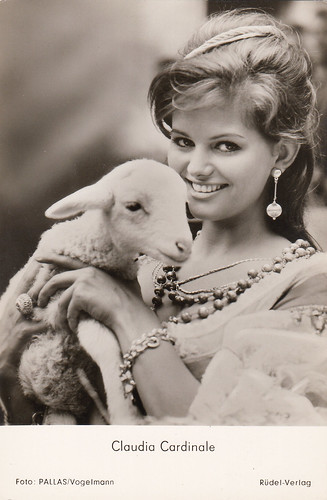
German postcard by Rüdel Verlag, no. 3561. Photo: PALLAS / Vogelmann. Claudia Cardinale in Cartouche (Philippe de Broca, 1962). Collection: Marlene Pilaete.
Italian actress Claudia Cardinale (1938) is one of Europe's iconic and most versatile film stars. The combination of her beauty, dark, flashing eyes, explosive sexuality and genuine acting talent virtually guaranteed her stardom. Her most notable films include the classics 8½ (Federico Fellini, 1963), Il Gattopardo (Luchino Visconti, 1963), and Once Upon a Time in the West (Sergio Leone, 1968).

German postcard by Rüdel Verlag, no. C 16. Photo: Rialto / Constantin / Vogelmann. Götz George in Der Schatz im Silbersee/The Treasure of Silver Lake (Harald Reinl, 1962).
German actor Götz George (1938-2016) was a popular film and theatre star for five decades. He gained international stardom on television in the Krimi series Tatort as the maverick police detective Horst Schimanski.
German postcard by Rüdel-Verlag, Hamburg-Bergedorf, no. 3972. Photo: Ringpress / Vogelmann / Löwant Columbia Bavaria. Alexandra Stewart in ...e la donna creò l'uomo/Full Hearts and Empty Pockets (Camillo Mastrocinque, 1964).
Canadian actress Alexandra Stewart (1939) started her film career in the French comedy Les Motards (1958), and has since then enjoyed a steady career in both French- and English-language films. Among her best films are some classics by Nouvelle Vague directors Louis Malle and François Truffaut.

German postcard by Rüdel-Verlag, Hamburg, no. 4766. Photo: Vogelmann / Constantin. Horst Buchholz in Cervantes (Vincent Sherman, 1967).
Horst Buchholz (1933-2003) was the James Dean of German Cinema. ‘Hotte’ was typecasted as a rebellious teenager in the late 1950s. He appeared in over sixty films between 1952 and 2002 and is now best remembered as the Mexican gunfighter Chico in The Magnificent Seven (John Sturges, 1960).
Sources: Filmportal (German) and IMDb.
No comments:
Post a Comment